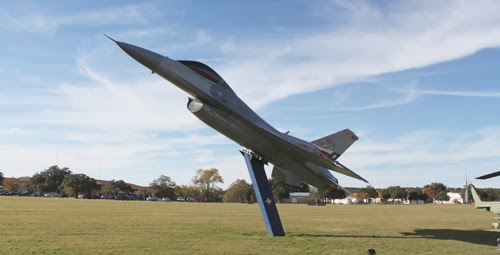Fixed Wing Aircraft Display
Camp Mabry's Texas Military Museum has on display three of the most successful jet fighters in Air Force history.
On display are three historic fixed wing aircraft and three iconic helicopters along the perimeter fence and visible from Mopac, Loop 1 Expressway.
Fixed Wing Display
Fixed Wing Display
F-86D "Sabre Dog" The first exclusively rocket armed, all weather fighter.
F-4C "Phantom" The Vietnam War era workhorse.
F-16 "Fighting Falcon" Served in all gulf wars and currently deployed around the world.
All planes are available for public viewing.
See links at the end of each plane to see more detailed data, actual vintage film clips, cockpit videos and music from the various time periods.
Example of videos on linked posts: Phantom F-4 and the Blue Angels 1970's. 3 minutes.
F-4C "Phantom" The Vietnam War era workhorse.
F-16 "Fighting Falcon" Served in all gulf wars and currently deployed around the world.
All planes are available for public viewing.
See links at the end of each plane to see more detailed data, actual vintage film clips, cockpit videos and music from the various time periods.
Example of videos on linked posts: Phantom F-4 and the Blue Angels 1970's. 3 minutes.
The F-86D was an all weather fighter. The all missile armament carried by the F-86D is mounted in a retractable tray in the fuselage just behind the nose wheel well. When the rockets are fired the tray drops below the fuselage and up to 24 2.75 inch folding fin aircraft rockets can be fired.
This plane was flown by all three Texas National Guard flying units in an air defense mission.
General characteristics
- Crew: 1
- Length: 40 ft 3 in (12.27 m)
- Wingspan: 37 ft 1.5 in (11.31 m)
- Height: 15 ft in (4.57 m)
- Empty weight: 13,518 lb (6,132 kg)
- Gross weight: 19,975 lb (9,060 kg)
- Powerplant: 1 × General Electric J47-GE-17B, 5,425 lbf (24.1 kN)dry, 7,500 lbf (33.4 kN) with afterburner
Performance
- Maximum speed: 693 mph (1,115 km/h)
- Maximum speed: Mach .91
- Range: 330 miles (531 km)
- Service ceiling: 49,750 ft (15,163 m)
- Rate of climb: 12,150 ft/min (61.7 m/s)
Armament
- 24 × 2.75 in (70 mm) Mighty Mouse FFAR rockets in ventral tray.
For more F-86D data, Korean War era music, film clips and short history.
McDonnell Douglas F-4C Phantom II
The F-4C Phantom is a twin engine two seat long-range all weather interceptor and attack bomber. It was developed for close support and attack duties with the tactical air command. The first F-4C flew on May 27, 1963. It was used as an air defense (147th fighter interceptor group) and then air to ground plane (149th fighter group in the Texas air National Guard.
The F-4 Phantom production ran from 1958 to 1981, with a total of 5,195 built. This extensive run makes it the second most-produced Western jet fighter, behind the F-86 Sabre at just under 10,000 aircraft.
The F-4C's General characteristics
- Crew: 2
- Length: 63 ft 0 in (19.2 m)
- Wingspan: 38 ft 4.5 in (11.7 m)
- Height: 16 ft 6 in (5.0 m)
- Wing area: 530.0 ft² (49.2 m²)
Performance
- Maximum speed: Mach 2.23 (1,472 mph, 2,370 km/h) at 40,000 ft (12,190 m)
- Cruise speed: 506 kn (585 mph, 940 km/h)
- Combat radius: 367 nmi (422 mi, 680 km)
For more F-4C data, Vietnam War era music, film clips and short history.
The General Dynamics (now Lockheed Martin) F-16 Fighting Falcon is a single-engine multi role fighter aircraft originally developed by General Dynamics for the United States Air Force (USAF). Designed as an air superiority day fighter, it evolved into a successful all-weather multi role aircraft. Over 4,500 aircraft have been built since production was approved in 1976.[2] Although no longer being purchased by the U.S. Air Force, improved versions are still being built for export customers.
The F-16's General characteristics
- Crew: 1
- Length: 49 ft 5 in (15.06 m)
- Wingspan: 32 ft 8 in (9.96 m)
- Height: 16 ft (4.88 m)
Performance
- Maximum speed:
- At sea level: Mach 1.2 (915 mph, 1,470 km/h)[57]
- At altitude: Mach 2[1] (1,320 mph, 2,120 km/h) clean configuration
- Combat radius: 340 mi (295 nmi, 550 km)on a hi-lo-hi mission with four 1,000 lb (450 kg) bombs
9/11 and Beyond Exhibit. Focus on Camp's F-16. - 5 minutes.
For more F-16 data, 1990's era music, videos and short history.

























